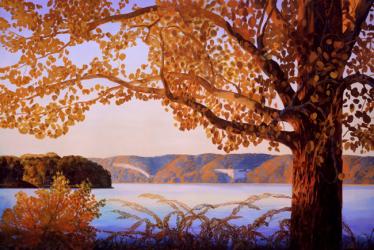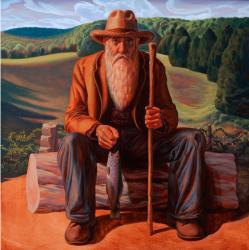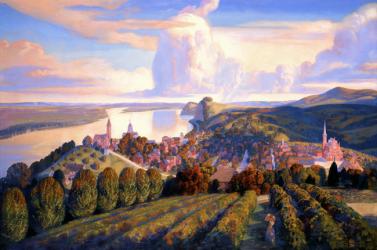With simple acrylics and an open canvas, Bryan Haynes paints life into Missouri landscapes, awakening an interpretation rooted in both the past and present. After years of travel and education, Haynes moved back to his home state of Missouri and settled in an area surrounded by towering trees in lush forests and an endless stretch of rolling plains. Inspiration beamed through every window and burst through every open door.
A mastery of the tools and techniques of paint allowed Haynes to create deeper meaning in his art, and soon, his paintings began to echo the style of 1930s Regionalism. “It really wasn’t on purpose, it just kind of percolated over the years,” says Haynes. “It’s almost as if the Missouri landscape suggests forms for a representational artist to include in his or her work.”
Understanding what the Regionalist artists of the 1930s saw in this rural landscape has spiraled Haynes into a revitalized style of his own. Also doubling as the title for his recent book, Haynes’ “New Regionalism” style resonates with most because it speaks of memories uncluttered by technology. “We all desire to look back a little bit and feel something familiar and handmade,” says Haynes. In his art, he lets the sweeping landscapes set the stage for the figures that belong there. Each piece is unique in its message to the viewer because the interpretation is combined with personal experience.
As Haynes understands and develops his style, he has realized that it fits in with an even larger movement of this generation. His New Regionalism art style parallels common trends in current society, such as the locavore food movement, the slow food movement, farmers markets and the resurgence of handcrafted items, says Haynes. As technology advances and the digital world becomes more prominent, there is an equally prevalent need for local community and a presence with nature.
Nestled in nature and true to his technique, Haynes still could not ignore the looming technological boom. Digital illustrators popped up with every new generation. As his traditional illustration continued to advance, he also taught himself from scratch how to bring his style onto the illuminated computer screen. Yet every illustration Haynes completes, traditional or digital, begins with a hand-drawn sketch.
“The computer is such a powerful tool that you can let it take over with really fancy effects and so forth,” says Haynes. “But you have to keep your idea in mind and not stray from your basic, simple concept.” The digital canvas comes with thousands of colors and a tool for every texture, but a handmade traditional illustration made from simple colors, acrylic paint and the movement of a brush on a canvas is timeless.











